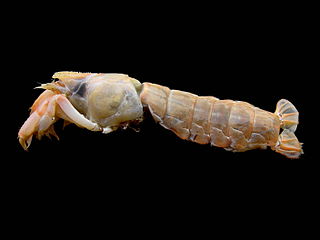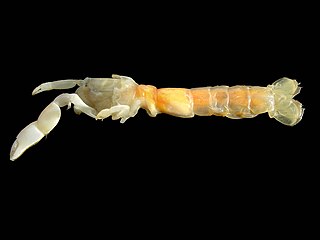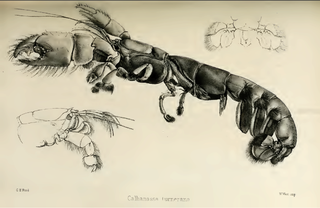
Mary Jane Rathbun was an American zoologist who specialized in crustaceans. She worked at the Smithsonian Institution, often unaided, from 1884 until her death. She described more than a thousand new species and subspecies and many higher taxa.

Thalassinidea is a former infraorder of decapod crustaceans that live in burrows in muddy bottoms of the world's oceans. In Australian English, the littoral thalassinidean Trypaea australiensis is referred to as the yabby, frequently used as bait for estuarine fishing; elsewhere, however, they are poorly known, and as such have few vernacular names, "mud lobster" and "ghost shrimp" counting among them. The burrows made by thalassinideans are frequently preserved, and the fossil record of thalassinideans reaches back to the late Jurassic.

The Cape lobster, Homarinus capensis, is a species of small lobster that lives off the coast of South Africa, from Dassen Island to Haga Haga. Only a few dozen specimens are known, mostly regurgitated by reef-dwelling fish. It lives in rocky reefs, and is thought to lay large eggs that have a short larval phase, or that hatch directly as a juvenile. The species grows to a total length of 10 cm (3.9 in), and resembles a small European or American lobster; it was previously included in the same genus, Homarus, although it is not very closely related to those species, and is now considered to form a separate, monotypic genus – Homarinus. Its closest relatives are the genera Thymops and Thymopides.

Nomascus is the second-most speciose genus of gibbons. Originally, this genus was a subgenus of Hylobates, and all individuals were considered one species, Hylobates concolor. Species within Nomascus are characterized by 52 chromosomes. Some species are all black, some are light with a distinct black tuft of crown fur, and some have distinct, light-colored cheek patches. Nomascus is found from southern China (Yunnan) to southern Vietnam, and also on Hainan Island. One species, Nomascus nasutus, has been deemed "the most critically endangered ape species in the world". All species in this genus are either endangered or critically endangered.
Callianassa can refer to:

Upogebia is a genus of mud shrimp, in the family Upogebiidae, containing the following species:

Callianassidae is a family of ghost shrimp of the order Decapoda.

Callianassa is a genus of mud shrimps, in the family Callianassidae. Three of the species in this genus have been split off into a new genus, Pestarella, while others such as Callianassa filholi have been moved to Biffarius.

Gilvossius tyrrhenus is a species of thalassinidean crustacean which grows to a length of 70 mm (2.8 in). It lives in burrows in shallow sandy parts of the sea-bed in the Mediterranean Sea and northern Atlantic Ocean. It is the most common thalassinidean in the Mediterranean, and has been used as bait by fishermen for at least 200 years.

Thalassina is a genus of mud lobsters found in the mangrove swamps of the Indian Ocean and western Pacific Ocean. Its nocturnal burrowing is important for the recycling of nutrients in the mangrove ecosystem, although it is sometimes considered a pest of fish and prawn farms.

The K'Ho, Cơ Ho, or Koho are an ethnic group living in the Lâm Đồng province of Vietnam's Central Highlands. They speak K'Ho language, a southern Bahnaric branch of Mon–Khmer language. They are related to the Cho Ro and Mạ people.

Hồ Ngọc Hà is a Vietnamese model, pop singer, actress and entertainer.
Clausidium vancouverense, the red copepod, is a symbiont of the ghost shrimp Neotrypaea californiensis. It is one of six species in the genus Clausidium and is found with its host in the Pacific Ocean from Alaska to Baja California.

Neotrypaea californiensis, the Bay ghost shrimp, is a species of ghost shrimp that lives on the Pacific coast of North America. It is a pale animal which grows to a length of 11.5 cm (4.5 in). One claw is bigger than the other, especially in males, and the enlarged claw is thought to have a function in mating. N. californiensis is a deposit feeder that lives in extensive burrow systems, and is responsible for high rates of bioturbation. It adversely affects oyster farms, and its numbers are controlled in some places by the application of pesticides. It carries out an important role in the ecosystem, and is used by fishermen as bait.
Biffarius is a genus of ghost shrimp in the family Callianassidae, containing species formerly included in the genus Callianassa. Its members are small and generally live in the intertidal zone. In April 2020, a new species was described from the northeastern Brazilian coast. Biffarius was named in honour of Thomas A. Biffar, and includes the following species:

Lepidophthalmus turneranus, the Cameroon ghost shrimp, is a species of "ghost shrimp" or "mud lobster" that lives off the coast of West Africa. It occasionally erupts into dense swarms, one of which resulted in the naming of the country Cameroon.
Calliapagurops is a genus of mud shrimp containing two species:

The blind goby is a species of fish in the goby family, the only species in the genus Typhlogobius. It is native to the coastlines of southern California in the United States and Baja California in Mexico, where it commonly inhabits the burrows of shrimp of the genus Callianassa. The adult of the species is completely blind and lacks pigmentation, while the juvenile has rudimentary eyes that help it find the shrimp burrows. This species can reach a length of 8.3 centimetres (3.3 in) TL.

Acanthaxius is a genus of mud lobster native to the Indo-Pacific oceans. It has a slender rostrum which is longer than the eyestalks, is spinose and has seven spines and has a depth range of 228–438 metres (748–1,437 ft). It includes the following species:
Hồ Bích Ngọc is a Vietnamese singer-songwriter and celebrity. She rose to fame in 2003 after winning the Television Voice Contest Tiếng hát Truyền hình HTV.













